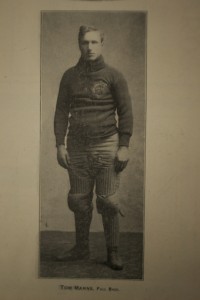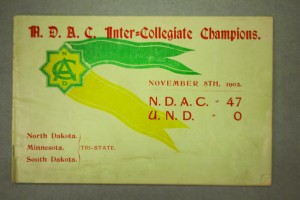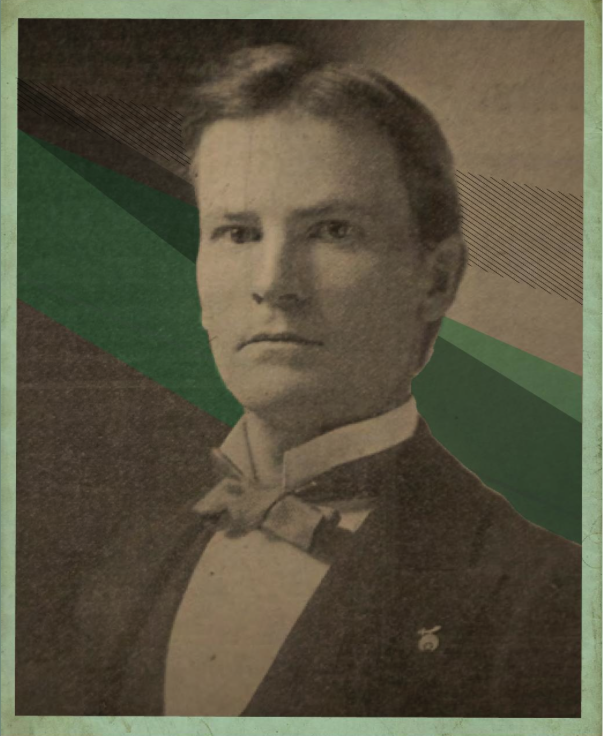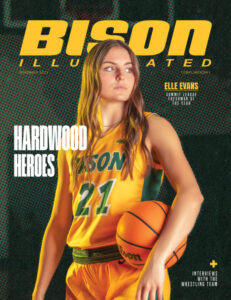Cover Letter
Mr. C. C. Finnegan,
State College Station,
Fargo, N. Dak.
Dear M. Finnegan:
I inclose a sketch of football at the North Dakota Agricultural College. I hope it may serve the purpose of yourself and Mr. Christy Welsh.
Unfortunately, in the early days of the institution, definite records do not seem to have been kept of many of of the features requested by Mr. Welsh. Carful reading of the athletic section of the FARGO FOURM, the SPECTRUM, the AGASSIZZ and the BISON should make it possible to pick out for the records most of the facts. The files of the SPECTRUM and the FORUM list some of the most important games, particularly those with the University, Carleton, St. Thomas, Yankton, McAllister, South Dakota, Creighton, Lawrence, Heske, Montana and other teams. The scores are usually stated.
The historical sketch necessarily only touches a few high points. As given, it is
Yours truly,
Henry L. Bolley,
Botanist and Plant Pathologist.
Henry L. Bolley Letter
December 26, 1933
Football At the North Dakota Agricultural College
“Indiana is a good state to come from,” Hoosiers agree. Many outside teams have learned that a good brand of sport has flourished there. North Dakota definitely owes the origin of its aspirations in football to enthusiasms engendered in Indiana. In the “dark ages”, early 80’s, there existed in Indiana a “football league”, the number-colleges of which were Purdue, Indiana, Hannover, Franklyn, Wabash and De Pauw. A type of soccer was played. This early effort became defunct in 1883. In 1886-87, a new league consisting of Purdue, Indiana, De Pauw, Butler and Wabash flourished largely because numerous enthusiastic Hoosier graduates of Yale, Harvard and Princeton were available as volunteer coaches.
In 1889 there was played at Crawfordsville, a strenuous game between Wabash and Purdue. Because of this game and the success of the Purdue team as coached by A. Weisner of Yale the Crawfordsville papers first supplied the epithets “gravel pit players”, “boilermakers” and “pumpkin huskers” to the Purdue team. “Boilermakers” stuck. Later Purdue teams cherished and punched that name on high. Much credit must be given to this early Indiana league and associated fans, George Ade, Chicago Athletic Association, at al, for the early, vigorous spirit of play is the Central West.
In 1890, when the writer came here as a member of the first faculty of the North Dakota Agriculture College, he found at the University a fellow botanist, Prof. M. A. Brannon, personal opponent and member of the Wabash team at the time of the Purdue victory in 1889. Remembering that spiritful game, he suggested that the contest at once be continued in North Dakota, between the two state institutions. That would have been easy for the “U”, for it was the original territorial university of the two Dakotas and had a sizable student body. Though anxious to try out as a volunteer coach, it was three years before I was able to find sufficient students to line up in scrimmage. The first games between the University of North Dakota and North Dakota Agricultural College occurred in 1894. Not having many nearby colleges to furnish cash and game experience, neither team had had much practice other than demonstrated by the over enthusiastic volunteer faculty coaches. To help develop interest, an agreement called for two games. This “game end return game” prevailed for a number of years thereafter.
 The game of ’94 were both won by the A.C. (NDSU) and of those of ’95, the first was won by the U. (UND), and the second by the A.C.
The game of ’94 were both won by the A.C. (NDSU) and of those of ’95, the first was won by the U. (UND), and the second by the A.C.
Later, a local league was formed between the various colleges of South Dakota, Minnesota and North Dakota, and during the next decade games were chiefly with South Dakota, Huron, McAllister, Hamlin, Carleton, St. Thomas and the Minnesota State Normal at St. Cloud. Intermittent games were played with the State College and the U. of Montana. Later, games with Creighton, Haskel and Marquette followed.
Previous to 1900, H. L. Bolley was coach and general manager with volunteer aids as available. Strong teams developed, but victory often lay with the opponents. Worthwhile football spirit gradually came out of the local high schools, but players for the College teams yet came largely as raw material from the farms. The annual games between the two state institutions became spirited, sturdy contests viewed with almost fighting enthusiasm by the public.
In the fall of ’98, a board of athletic control was elected consisting of two faculty members and three students. This board and its successors have continued to function. Professor Bolley continued as general manager until 1909.
Mr. Jack Harrison, noted end and quarterback (Minnesota) was assistant coach in 1900 and 1901 for six weeks each fall and was in charge of the team in the field. He found a member of well prepared players including Fred and John Slate, Tom Manns, Spelisey, Worat, Wilde, John Swenson, Olson, McGuigan and others. Harrison was an astute coach in field action. He seemed to have intuitive sense of directing individual players into finished play. The major games were with Carleton, Hamelin, McAllister, South Dakota and the U. of N.Dak. No games were lost.
Following Harrison, “Eddie” Coohems (Wisconsin) handled the teams of 1902 and 1903. He was the first official athletic director. There has been an athletic director and assistant coaches of full official faculty status in control of all teams since 1902. Coohems was selected because of all around athletic qualifications and he developed winning teams in all lines. During his regime the manager provided outfits for all who wished to enter a class or group team. Coohems was a specialist in physical training and delighted in training the various teams. To him fell the honor of building the first effective basketball team, and efficient track team, high class baseball and a special type of open play football. He forced open play through speed and accurate passing. His system involved intricate throwing of the ball in long lateral, and varied back passes, often to such distances as to admit the receiver to an open field through which to race into well guarded finished runs. Later, at St. Louis University, his winning teams, the writer thinks, should give to him credit for about the earliest effective use of the forward passing system, not then generally accepted as of much merit.
A.L. Marshall (Michigan) coached the 1904 and 1905 teams with but ordinary results.
Gilmore Dobie, quarterback and end (Minnesota), Cornell’s present efficient coach, was made director of athletics and the team of 1906 and 1907 leaped into prominence. This was Dobie’s first effort and his teams have come down in history as one a too finished for ordinary teams. Victories under Dobie’s skilled coaching, strange to say, brought a type of football depression in North Dakota, largely because enthusiasm waned as the victories came too easy. He used classroom methods and effectively proved systematic attack to be best defense. At this time Dobie introduced a system whereby few signals were called, player ran in series. Generally, after on call, three or more plays were reeled off in rapid succession without confusion. His was a silent, relentless attack. There was no stalling or conferences when once within the enemies 20-yard line. Dobie knew a player when he saw him, whether from farm or high school. No time was lost on men of small initiative or ineffective execution. His teams were physically fit, and there was need for few substitutes.
Two field generals, Coohems and Dobie, each set high aspirations for future N.D.A.C. teams; and, as of old, the “Sioux” learned to fear the trampling “Bison.” Since those days there has been continued interest in the State and at the Institution. Each year it has been possible to place rather worthy teams in the field. As with other institutions, victory has not always followed the “herd, yet winners in most contests have had to be strong, wary and alert.
This article does not admit or comment as to most coaches, teams or players.
T.P. McGoffin (Michigan) was director in 1908 and 1909,
Arthur Ruber (Chattanuga) directed in 1910, 1911 and 1912,
Howard Woods (Michigan State), 1913 and 1914,
Paul Davis (Virginia), 1915 to 1916,
Stanley Borleskee (Michigan) was director from 1916 to 1924; and
Ion Cortwright (Michigan State), 1924 to 1928.
 During the period 1909 and 1928, there were many outstanding individual players, yet from the standpoint of an observer, team play was not always as much in evidence as might be desired. No plant is more sensitive to criticism and improper atmospheric conditions than football and none will be given here. Looking backward, there seems to be no serious cause for complaint. Ahead, the future is bright for football at the
During the period 1909 and 1928, there were many outstanding individual players, yet from the standpoint of an observer, team play was not always as much in evidence as might be desired. No plant is more sensitive to criticism and improper atmospheric conditions than football and none will be given here. Looking backward, there seems to be no serious cause for complaint. Ahead, the future is bright for football at the
N.D.A.C.
Mr. C. C. Finnegan (Ripon) is athletic director and head coach. The institution has reached a position of major importance in the State in the number of student. Their qualifications and accomplishments along varied linear of activity give expectations of efficient teamwork in the future.
In football, the large numbers in the larger institutions usually give coaches and advisers superior possibility of building effective teams. New systems of handling teams and substitute teams have come along. Coaches do not now rely on the skill of a few select men and a few substitutes but rather upon substitute teams. These developments make the selection of outstanding All-American type of players difficult, and to compare players of present times with those of bygone years with relative accuracy is quite impossible. Yet, as observer of numerous games in various parts of the United States from 1890 to 1933, I do not hesitate to list such men as French, Fred Sleight, Manns, L. Nemzek, Spelissy, Byron Wild, Ed. McDonald, Rose, Wicks, Jack Marks, Walter Jacobson, Joe Cutting, Corbett, Muckelstone, Claude Miller, Lounsborogh, Jahr, Roman Meyers and McKay as men who could have won places on leading teams of the country at any time.
Football has been the major sport of the North Dakota Agricultural College. The schedule of games and eligibility of players have always been under control of competent athletic boards and coaching management. The institution is closely associated in the North Central Conference which carries under its regulations football, basketball, baseball, tennis and track. In this league the various institutions are of such relative rank and worth that there is reason to expect football in the Northeast and at the N.D.A.C. will continue in a stable, satisfactory growth.




